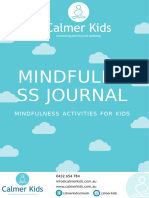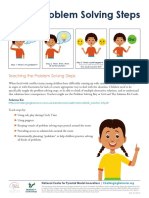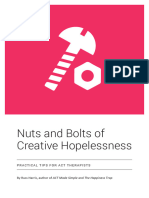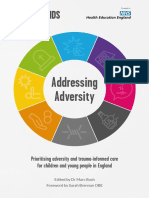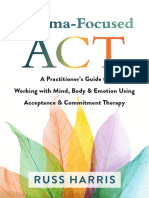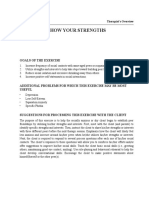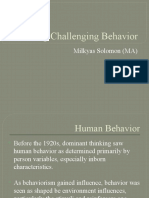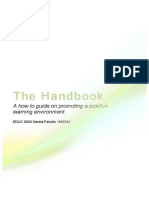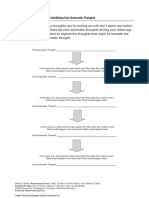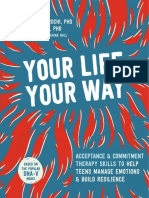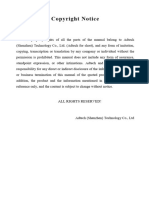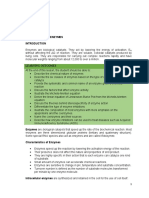Anger Management For Teens: by Fredric Provenzano, PHD, NCSP Seattle, Wa
Anger Management For Teens: by Fredric Provenzano, PHD, NCSP Seattle, Wa
Uploaded by
piyushCopyright:
Available Formats
Anger Management For Teens: by Fredric Provenzano, PHD, NCSP Seattle, Wa
Anger Management For Teens: by Fredric Provenzano, PHD, NCSP Seattle, Wa
Uploaded by
piyushOriginal Title
Copyright
Available Formats
Share this document
Did you find this document useful?
Is this content inappropriate?
Copyright:
Available Formats
Anger Management For Teens: by Fredric Provenzano, PHD, NCSP Seattle, Wa
Anger Management For Teens: by Fredric Provenzano, PHD, NCSP Seattle, Wa
Uploaded by
piyushCopyright:
Available Formats
ANGER MANAGEMENT FOR TEENS
By Fredric Provenzano, PhD, NCSP Seattle, WA
Theres no denying it. Everyone is likely to experience anger. A recent study found that adults feel anger, from moderate annoyance to rage, on the average of six times a day. Although the rate for children and adolescents has not been reported, we can assume that they are also likely to experience anger frequently. Anger also has a positive side. We feel angry when we feel threatened or wronged, and it gives us extra energy to deal with the problem. In that respect, were not unlike humans from eons ago, or even different from most other animals. Anger is part of what is known as the generalized alarm response, preparing us to threaten, fight, or run away (the three primitive and basic ways to solve a problem). While these three options may be very useful if were revved up because a bear is threatening our child or friend, it doesnt work in most of the social situations that we encounter today. Still, when our anger is moderate to intense, we experience that primitive and basic reaction. As our anger grows toward a rage, we lose our ability to reason logically. Instead, we make reactive, instinctual decisions, just like little kids.
Anger Versus Angry Response
It is important to see the difference between anger, which is a valid emotional reaction to perceived threat, and how we behave when were angry. Anger is a common, natural response that can have value, even survival value. There is nothing wrong or unusual about feeling angry. Still, it can be a very discomforting feeling. The problem with anger usually begins when this rapid anger reaction reduces our ability to reason. Then, what we do when we are angry may be impulsive, dangerous to ourselves or others, damaging, or even disruptive. There is potential for danger in both reacting aggressively and in trying to deny our feelings, which can contribute to depression or physical symptoms such as headaches, stomachaches, or ulcers.
Steps to Manage Anger
Steps in managing anger fall into two main stages. The first stage, tension management, involves assessing the anger or tension level and then taking steps to reduce it if were even approaching a danger level. The second stage, problem solving, involves using the remaining energy to fuel the action to solve the problem. However, it is extremely important to go through the first stage before trying to solve the problem. Tension Monitoring and Reduction Here are the steps to use in checking and reducing physical tension and anger: Step 1. Recognize your anger. Check your body signs. When youre tense, your body shows it in more than 600 different ways that prepare you to fight, threaten, or run away. Some of the more familiar and easier to recognize signs include increased heart rate/heart pounding; rapid, shallow breathing; face feeling hot; jaw tensing; fists clenching; feeling energy through the body; upset stomach; shoulders hunched. Step 2. Break from the action. If youre feeling even mild to moderate body tension, give yourself a stop command (Stop! Cool it! Chill!). Step 3. Relax/de-escalate. There are several ways you can do this. The easiest is relaxation breathing. Breathe slowly in through your nose and exhale very slowly through your mouth. Other methods include soothing self-talk (Im the boss of my body. I can manage myself.) or tensing and then relaxing various muscle groups.
Helping Children at Home and School II: Handouts for Families and Educators
S101
Step 4. Check your level of self-control. Ask yourself, Am I the boss of my body? Check your body signs for reduced tension. If you arent regaining selfcontrol, continue with step 3 or get away from the stressful situation. Problem Solving Once your tension is reduced so that you can reason more clearly, proceed to the following steps: Step 1. Define the problem. My problem is ______. I want ______ (to be left alone, to leave, an apology). I dont want ______ (to fight, get in trouble, hurt others feelings).
Step 2. Make a plan. The plan should address both what you want to accomplish and what you want to avoid. Include a back-up plan, so that if your first plan doesnt work, youll feel confident and less likely to feel angered again and wont have to repeat all these steps. Step 3. Implement your plan. Ask yourself, Am I following my plan? Is it working? If its not working, have you given it enough time to work, or is it time to switch to the back-up plan? Step 4. Evaluate your efforts. Be sure to give yourself credit for following your plan and managing your anger, even if it didnt turn out the way youd hoped. Some Pointers Recognizing anger: Since many people grow up with the message that anger is bad, most people tend to deny or minimize their recognition of their own anger. Some can also do this because they dont know how to manage their anger, and so they are afraid of it. Know your bodys signals: Identify and get to know two or three of your signs of tension. Choose ones that you are aware of and that you are aware of even when youre feeling only mild tension. Two or three are enough. If youre aware of your body tensing in these areas, you can be assured that its happening in many other ways also. Get to know what these body signs feel like so you can gauge your tenseness. Stress check: Some families or classrooms make a rule that anyone can call for a stress check whenever he or she feels tension building or becomes aware that it is building in others. When a stress check is called, everyone should mentally
give himself or herself a stop command and check body signs for tension level. This is important for everyone, because if one person in a group is becoming angered, others who are reading that anger may be feeling more tense and defensive. Take a break: If your efforts to de-escalate arent working and youre feeling like you might blow up into some inappropriate behavior, getting away from the tense scene is a good and prudent action. Take a break. Maybe say to the other person, Look, Im feeling so angry that I cant think straight and Im not hearing what you have to say. I need a break for 10 minutes to calm down. They are more likely to respect this request because youre not blaming them but instead taking responsibility for your own anger. When you include a time to resume the discussion, they know youre not just trying to get out of confronting whatever issue youre arguing about. Note: This technique works best if youve discussed it with family members or others beforehand so they understand whats going on. Plan ahead: While it can be better to verbalize your feelings, some kids (and adults) find this to be very difficult. If youre like very many others and cant say what it is thats making you angry, you may need to find alternative ways to express and release your tension. Plan ahead. Identify methods that dont hurt anyone or place anyone at risk (you or others). Dont break anything that is valuable, irreplaceable, or belongs to others or do anything that disrupts others, but still is effective in reducing the tension. Some families have identified places where family members can go to yell (basement, garage, inside a parked car) or some physical exertion (tearing up old newspaper, smashing ice cubes on the sidewalk) that is approved and wont be punished (so long as the newspaper gets cleaned up later). Youd be surprised how much family tension is avoided when someone goes to the approved place to yell instead of yelling at others, and demonstrates effective self-management rather than out-of-control disrespect for others. Substitute an acceptable behavior: If you are in the bad habit of yelling put-downs or names at others, try substituting roaring like a lion. This avoids saying things that you later regret. Most families who have used this technique report that they begin to laugh, breaking the tension and leading to a more cooperative interaction. Relax: Other tension reducers include tensing and the relaxing muscles, relaxation breathing (more on this later), visualizing a relaxing place, or counting slowly to 10. Try counting backward, and visualize a
S102
Anger Management for Teens
temper thermometer with the red liquid going down with each number as your tension reduces. Use humor: Humor is a great tension reducer. Use it liberally for yourself, but be careful about using this with others if theyre angry. They might think you are ridiculing them or not taking them seriously. Identify the cause: Anger is actually a reaction to other discomforting feelings of threat. Try to identify the primary feeling behind your anger. It may be feeling hurt, misunderstood, disrespected, or frustrated. When you identify this primary feeling, it will help to guide your action plan to resolve the anger. Find a balance: People who tend to think only about what they want and dont consider what they want to avoid will probably become aggressive. People who focus on what they want to avoid without balancing what they want are more likely to turn their anger inward, becoming passive, or depressed, or suffer from physical symptoms such as headaches or nausea. Respect yourself: We dont always get what we want, but we can still respect ourselves when we judge that weve managed ourselves effectively and havent been emotionally distracted from our plan.
Summary
Anger is a natural and functional response to perceived threats. When we learn to effectively manage our anger, we can direct that energy into positive solutions to our problems that respect others and ourselves.
Resources
The following books and games are available from the Creative Therapy Store, 12031 Wilshire Blvd., Los Angeles, CA 90025-1251; (800) 648-8857; www.creativetherapystore.com Berg, B. The anger control workbook. For grades 5 and up. Dr. Berg also has written self-help workbooks that cover social skills, social conflict, self-control, achievement, and the changing family. Rubinstein, F. From rage to reason. For grade 8 through adult. In this game, players follow Randy on his job and in his daily life, and earn money by giving Randy good advice about frustrating and angerprovoking situations. A relaxing way to learn about anger control and skills needed on the job and in the community. Wilde, J. Hot stuff to help kids chill out. For grades 412. A set of small books to help kids learn to handle angry feelings in constructive ways. Website Creative Therapy Storewww.creatvetherapystore.com This is a great resource for games that help kids identify inappropriate and harmful anger expressions and to replace them with more functional and helpful solutions that respect everyone involved. These games include Peacetown for elementary and middle school children and Sticks and Stones for the middle school and high school kids. Fredric Provenzano, PhD, NCSP, is a school psychologist in private practice in Seattle, WA.
2004 National Association of School Psychologists, 4340 East West Highway, Suite 402, Bethesda, MD 20814(301) 657-0270.
Relaxation Breathing
This is the most useful and readily available technique for reducing tension. It not only works in anger management, but also at other times when youre feeling tense or anxious. Actors, singers, athletes, and public speakers use it all the time. Its also helpful to use during tests if youre feeling worried. This technique may not make you feel totally relaxed in a tense situation, but can take the edge off your tension so that you can function more effectively. Heres the technique: Square your body, so that you are not twisted one way or the other. Rest your hands in your lap or on the arms of the chair if youre sitting. Position your arms by your sides if youre standing or lying down. Breathe in deeply and slowly through your nose. Fill your lungs. Youll know youre doing this when your lungs are so full that your stomach sticks out. Exhale slowly through your mouth. Dont push the air out, just open your mouth and let the air flow out gently by itself. Our body relaxes as we exhale, so the longer you can prolong this breathing out the more relaxed youll feel. (Dont hold your breath before starting to exhale. Holding your breath increases your tension instead of decreasing it.) Repeat this at least four times, but as often as you need to take the edge off your tension. Repeat whenever you start to feel the tension build again.
Helping Children at Home and School II: Handouts for Families and Educators
S103
You might also like
- Malaysian SNR EmperorDocument67 pagesMalaysian SNR Emperorinuka583788% (8)
- Caveman Mind Metaphors: by Dr. Russ HarrisDocument10 pagesCaveman Mind Metaphors: by Dr. Russ HarrisRaphaele ColferaiNo ratings yet
- Places That Matter: Knowing Your Neighborhood through DataFrom EverandPlaces That Matter: Knowing Your Neighborhood through DataNo ratings yet
- Helping Students Eliminate Inappropriate School Behavior: A Group Activities’ Guide for Teachers and CounselorsFrom EverandHelping Students Eliminate Inappropriate School Behavior: A Group Activities’ Guide for Teachers and CounselorsNo ratings yet
- Slender Column Moment MagnifierDocument8 pagesSlender Column Moment Magnifiermotiur basumNo ratings yet
- DBT Diary Card - BackDocument2 pagesDBT Diary Card - BackCiupi Tik100% (1)
- Calmer Kids Mindfulness JournalDocument32 pagesCalmer Kids Mindfulness JournalJoanna ZawadzinskaNo ratings yet
- Teaching The Problem Solving StepsDocument3 pagesTeaching The Problem Solving StepsZineil Blackwood100% (1)
- Learning To Cope With EstrangementDocument7 pagesLearning To Cope With EstrangementSOMYAJULA KAVYA100% (1)
- New Counselors Survival Guide 2Document28 pagesNew Counselors Survival Guide 2ANdeee sanahchNo ratings yet
- Nuts and Bolts of Creative Hopelessness - Ebook by Russ HarrisDocument13 pagesNuts and Bolts of Creative Hopelessness - Ebook by Russ HarrisTarique SaniNo ratings yet
- Stress Small Group Lesson PlansDocument4 pagesStress Small Group Lesson Plansapi-301334614No ratings yet
- Friendship Peer PressureDocument6 pagesFriendship Peer PressureConsuelo Godoy VeraNo ratings yet
- Adolescents Choosing Self-Harm As An Emotion RegulationDocument14 pagesAdolescents Choosing Self-Harm As An Emotion RegulationmiriamNo ratings yet
- Divorce and Separation Eced PresentationDocument20 pagesDivorce and Separation Eced Presentationapi-347007451No ratings yet
- Signs & Symptoms of An Eating DisorderDocument2 pagesSigns & Symptoms of An Eating DisorderWrendell BrecioNo ratings yet
- Helping Young Children Manage The Strong Emotion of AngerDocument6 pagesHelping Young Children Manage The Strong Emotion of AngerPopa Maria CristinaNo ratings yet
- TIPP HandoutDocument3 pagesTIPP HandoutCarl DorwanNo ratings yet
- Research Into Practice: in A NutshellDocument6 pagesResearch Into Practice: in A Nutshellnabanita buragohainNo ratings yet
- Teens in Distress SeriesDocument4 pagesTeens in Distress SeriesdarinaralucaNo ratings yet
- YM ACEsDocument187 pagesYM ACEssofia100% (1)
- Circle of Courage InterventionsDocument2 pagesCircle of Courage Interventionsapi-402325503No ratings yet
- Self - Harm - Workbook - 1726333427Document32 pagesSelf - Harm - Workbook - 1726333427Kamyla FernandaNo ratings yet
- Motivational Interviewing ToolsDocument3 pagesMotivational Interviewing ToolsMistor Dupois WilliamsNo ratings yet
- Elementary School Counseling Needs AssessmentDocument1 pageElementary School Counseling Needs Assessmentapi-494901707No ratings yet
- Social Phobia: Goals of The ExerciseDocument5 pagesSocial Phobia: Goals of The ExerciseAngela100% (1)
- CBT Handout HannahDocument2 pagesCBT Handout Hannahapi-273614596100% (1)
- The Brainflaw Handout PDFDocument3 pagesThe Brainflaw Handout PDFHarold LowryNo ratings yet
- ACT For Anger Group FINALDocument72 pagesACT For Anger Group FINALElaine Bedin100% (1)
- Keeping Your Balance - 08 - Coping With Psychosocial Stressors and Self-ManagementDocument13 pagesKeeping Your Balance - 08 - Coping With Psychosocial Stressors and Self-ManagementBogdanMînjinăNo ratings yet
- Self-Talk and Self-Esteem Lesson PlanDocument4 pagesSelf-Talk and Self-Esteem Lesson Planapi-548271395No ratings yet
- Panic Self HelpDocument4 pagesPanic Self HelpWanda FschraNo ratings yet
- Chapter One of Trauma Focused ACTDocument16 pagesChapter One of Trauma Focused ACTjulia2julia30No ratings yet
- Time4Me - Children's Bereavement Workbook (2) SMLDocument33 pagesTime4Me - Children's Bereavement Workbook (2) SMLTeri WILSONNo ratings yet
- 2024 ACTe CatalogDocument20 pages2024 ACTe CatalogJuan Alberto González100% (1)
- Show Your StrengthsDocument4 pagesShow Your StrengthsAngelaNo ratings yet
- Health Anxiety Module 6Document13 pagesHealth Anxiety Module 6madixxxxNo ratings yet
- Sress LogDocument7 pagesSress LogsivanNo ratings yet
- ACT Made Simple - The Extra Bits - by Russ Harris - Textbook Support Materials - June 2023 UpdateDocument7 pagesACT Made Simple - The Extra Bits - by Russ Harris - Textbook Support Materials - June 2023 Updatepsiho2024100% (1)
- Social Anxiety Screening ToolDocument5 pagesSocial Anxiety Screening ToolKurt CutayNo ratings yet
- How To Calm The Agitated Student Intervention CentralDocument3 pagesHow To Calm The Agitated Student Intervention Centralapi-341096973No ratings yet
- Individual Values Assessment - An UpdateDocument3 pagesIndividual Values Assessment - An Updatedarff45No ratings yet
- Stabilisation ManualDocument12 pagesStabilisation ManualLaura AndreiNo ratings yet
- (Client's Self-Report of Problems, Progress) :: Elim HomeDocument1 page(Client's Self-Report of Problems, Progress) :: Elim HomeKymberley Gillespie Andrews100% (1)
- Putting It Into PersepectiveDocument4 pagesPutting It Into PersepectiveAngelaNo ratings yet
- Anger Management InterventionsDocument10 pagesAnger Management InterventionsAsih Nor Zahidah100% (1)
- Coping With Suicidal Thoughts - 2 PDFDocument7 pagesCoping With Suicidal Thoughts - 2 PDFModiNo ratings yet
- Defining Challenging Behavior by Milkyas SolomonDocument52 pagesDefining Challenging Behavior by Milkyas SolomonVerity SplendourNo ratings yet
- Small Group CounselingDocument43 pagesSmall Group CounselingJean EstrebillaNo ratings yet
- 4 Foundations To Help Trauma-Impacted YouthDocument4 pages4 Foundations To Help Trauma-Impacted Youthwaleskacrz100% (1)
- Handbook GoodpdfDocument16 pagesHandbook Goodpdfapi-365069953No ratings yet
- Career Exploration and PlanningDocument18 pagesCareer Exploration and PlanningJomole JosephNo ratings yet
- 8.2 Downward ArrowDocument1 page8.2 Downward ArrowLinnea Sepe-ForrestNo ratings yet
- ACT Training Manual For Substance Abuse CounselorsDocument9 pagesACT Training Manual For Substance Abuse CounselorsSiro Vaquero CabezaNo ratings yet
- Trauma Focused: Russ HarrisDocument400 pagesTrauma Focused: Russ HarrisvaleriaNo ratings yet
- Assessing Perceived Social SupportDocument5 pagesAssessing Perceived Social SupportFilipe BoilerNo ratings yet
- Ylyw Free ChapterDocument17 pagesYlyw Free ChapterLUCIANENo ratings yet
- Coping With Stress in Middle and Late AdolescenceDocument3 pagesCoping With Stress in Middle and Late AdolescenceCharles FajardoNo ratings yet
- Emotion Processing WorksheetsDocument12 pagesEmotion Processing WorksheetsNadine Innes100% (1)
- Healing Inside Out And Outside In: Finding Zen through Spriritual HealingFrom EverandHealing Inside Out And Outside In: Finding Zen through Spriritual HealingNo ratings yet
- Anger Management: A Step By Step Instruction Handbook on How To Control and Manipulate Excessive Anger In A Healthy and Safe WayFrom EverandAnger Management: A Step By Step Instruction Handbook on How To Control and Manipulate Excessive Anger In A Healthy and Safe WayNo ratings yet
- A Good Thesis Statement For William ShakespeareDocument5 pagesA Good Thesis Statement For William Shakespeareafiwgbuua100% (2)
- 3082-Article Text PDF-6840-1-10-20130718 PDFDocument13 pages3082-Article Text PDF-6840-1-10-20130718 PDFAndrea ZarazuaNo ratings yet
- May 12, 2017 Strathmore TimesDocument32 pagesMay 12, 2017 Strathmore TimesStrathmore TimesNo ratings yet
- Delivery Note For Team AfourDocument1 pageDelivery Note For Team AfourshoaibNo ratings yet
- Brocade Web Tools: A Better Way To Monitor and Manage SAN FabricsDocument4 pagesBrocade Web Tools: A Better Way To Monitor and Manage SAN Fabricsgoldseeva1No ratings yet
- National Conference On Innovations in Chemical Sciences (NCICS-2020)Document1 pageNational Conference On Innovations in Chemical Sciences (NCICS-2020)Hemanth Peddavenkatappa GariNo ratings yet
- Busi 1110 Assignment2Document2 pagesBusi 1110 Assignment2DanNo ratings yet
- Vedanta Sandesh - Nov 2020Document58 pagesVedanta Sandesh - Nov 2020Swami AtmanandaNo ratings yet
- Qs7 ManualDocument56 pagesQs7 ManualUsama ZaheerNo ratings yet
- EnzymeDocument15 pagesEnzymeSheena Mhae LopeñaNo ratings yet
- Region 2: Provinces AreDocument2 pagesRegion 2: Provinces AreMariNo ratings yet
- O Level Physics NotesDocument6 pagesO Level Physics NotesHamza Kahemela86% (7)
- Perioperative Services IC0059Document31 pagesPerioperative Services IC0059alibaalbake1997No ratings yet
- Order Details Specifications L462 L462 2.0P AJ20-P4H AWD 5DR SWB SE 300PS Auto, India IND, HC462/351QH, 2020 2020 Model YearDocument3 pagesOrder Details Specifications L462 L462 2.0P AJ20-P4H AWD 5DR SWB SE 300PS Auto, India IND, HC462/351QH, 2020 2020 Model YearJay ShahNo ratings yet
- Norsok M 122 Ed 2012 Cast Structural Steel - CompressDocument20 pagesNorsok M 122 Ed 2012 Cast Structural Steel - CompressAndy TaylorNo ratings yet
- Thermoplstic Resins:Polyethylene & Polypropylene: Hermoplastics. Less Rigid ThanDocument8 pagesThermoplstic Resins:Polyethylene & Polypropylene: Hermoplastics. Less Rigid ThanRahul SinghNo ratings yet
- Financial and Non-Financial Risk Attitudes What Does It Matter - ScienceDirectDocument2 pagesFinancial and Non-Financial Risk Attitudes What Does It Matter - ScienceDirectMeryem AfayaNo ratings yet
- Literary ThemesDocument36 pagesLiterary ThemesTeresita AbellonNo ratings yet
- Clients For Ld7019ec 3155 1070Document8 pagesClients For Ld7019ec 3155 1070abhimanyu.xplastNo ratings yet
- Markem Imaje 8018 DS HQ A1 SDocument2 pagesMarkem Imaje 8018 DS HQ A1 SJasidNo ratings yet
- Acc 150 Merged CompleteDocument94 pagesAcc 150 Merged Completedelossantosellamae838No ratings yet
- MTP_41_54_ANSWERS_1735023711 (1)Document15 pagesMTP_41_54_ANSWERS_1735023711 (1)230275No ratings yet
- Introduction, Branches, Terms of Anatomy and Study of Anatomical PlanesDocument16 pagesIntroduction, Branches, Terms of Anatomy and Study of Anatomical PlanesShaik MadeenaNo ratings yet
- Tugas Dr. Domingos Da SilvaDocument6 pagesTugas Dr. Domingos Da Silvadenilay richardoNo ratings yet
- New Curriculum BSEC English PHDocument1 pageNew Curriculum BSEC English PHMadelle Dela CruzNo ratings yet
- DLL Gen Physics 1 Q1 Week 1 - 2024-2025Document5 pagesDLL Gen Physics 1 Q1 Week 1 - 2024-2025marilou garciaNo ratings yet
- Final PaperDocument48 pagesFinal PaperRenalyn de VillarNo ratings yet
- Casing Centralizer Series - 1 - Types of Centralizers - Pegasus Vertex, Inc. - BlogDocument3 pagesCasing Centralizer Series - 1 - Types of Centralizers - Pegasus Vertex, Inc. - BlogNihad PaşazadəNo ratings yet







